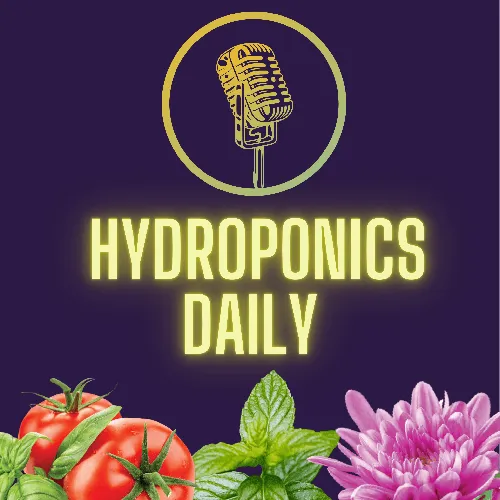
Hydroponics Daily
Daily clips of hydroponic science
Presented by Dr Russell Sharp
Brought to you by the team behind Gold Leaf - seed to harvest with just one bottle of feed
- Update frequency
- every day
- Average duration
- 8 minutes
- Episodes
- 248
- Years Active
- 2025

Far-Red Revolution: Could Chlorophyll D/F Boost Indoor Crop Yields?
Dr. Russell Sharp reviews a new Nature Communications paper (Wang et al.) exploring the idea of adding chlorophyll d and f to crops so they can use far-red light (700–800 nm). The paper models up to …

Hidden Light Signals: How the Red:Far‑Red Ratio Controls Plant Growth
Dr. Russell Sharp explores the critical red-to-far-red (R:FR) light ratio, how phytochrome senses these wavelengths, and how that signal shapes germination, stem elongation, flowering, and canopy arc…

Mylar vs Matt White: The Truth About Grow Tent Reflectivity
Dr. Russell Sharp explains how different grow tent materials — metallized PET/mylar, white films, panels and paints — affect reflectivity, light uniformity and photosynthetic efficiency, and why comm…

Hydroponics Daily: No Soviet Secret Labs — Just Space Pizza
Dr. Russell Sharp presents a brief Hydroponics Daily update covering myths about Soviet hydroponics, unusual crops like dragon fruit and the Annona family, and a botanical note about magnolia tepals.
…
Green Hope in the Aral Desert: Hydroponics Feed the Future
Dr. Russell Sharp examines a UNDP-led hydroponics project in the Aral Sea region that grows fast, soilless wheat and alfalfa fodder to address polluted, infertile land and livestock feed shortages.
T…

Whitefly Secrets Part 2 : Life Cycle, Damage & Control
Dr. Russell Sharp explains the whitefly life cycle, why they hide under leaves and how to control them in hydroponic systems. He also shares microgreen hydroponic tips and the importance of removing …

Whiteflies Part 1: Protect Your Grow
Dr Russell Sharp explains what whitefly are, why they threaten greenhouse and outdoor hydroponic crops, and how to detect them early.
The episode covers monitoring methods, prevention (filters, airfl…

Sodium: The Silent Killer in Hydroponics
Dr. Russell Sharp explains why sodium is highly toxic to plants, how it damages cellular functions, causes nutrient imbalances and reduces yield, and why osmotic stress is not the only issue.
He outl…

From Vertical Farm to Field: A Harsh Lesson in Transplant Shock
Dr. Russell Sharp shares a Liverpool tour and a farmer's rhubarb story that highlights how fragile indoor-grown plants can be when transplanted outdoors.
The episode outlines why hardening off and we…

Hello Darkness, My Microgreens' friend: Embracing the Dark for Bigger, Sweeter Shoots
Dr. Russell Sharp explains why deliberately growing microgreens in darkness produces taller, sweeter, and easier-to-harvest seedlings. He shares observations from trials with basil, mustard, pea shoo…

Free Hydroponics Samples — Review on Apple Podcasts to Claim Yours
Dr. Russell Sharp invites listeners to Hydroponics Daily to get a free sample in exchange for an Apple Podcasts review — just screenshot your review and email it to him to claim a product.
Available …

Growing Crops on Mars: Hydroponics Beyond Earth
In this episode Dr. Russell Sharp explores the practical science of growing crops on Mars — water sources and site choices, lighting and power options, and why indoor, LED‑lit hydroponics (NFT, aerop…

Beat the Bloom: Practical Algae Control for Hydroponic Reservoirs
Dr. Russell Sharp of Eutrema Limited breaks down why algae is a problem in hydroponic and greenhouse reservoirs—how it competes for nutrients and oxygen, clogs lines, and risks crop and food-safety i…

Who’s Steering Hawthorne? The Mysterious Buyout of Scotts’ Hydroponics Empire
This episode of Hydroponics Daily unpacks the rise of Hawthorne Horticulture, a Scotts Miracle-Gro subsidiary (Hagedorn family) that bought major hydroponic brands like Gavita, General Hydroponics an…

Belgium's Hydroponic Leek Leap: 3,000 m² Farm in Ypres
Dr. Russell Sharp explores a new 3,000 m² commercial hydroponic leek facility in Ypres, Belgium, developed by Agro Reo, Hydromasters and Endura with VLEA and EU support.
The outdoor deep-water system…

Game-Changer for Growers? Nordetect’s Handheld Nutrient Tester
Dr. Russell Sharp reviews Nordetect’s upcoming handheld tester that measures nitrogen, phosphorus, potassium, calcium, magnesium and sulfur in fertigation streams using a patented agrochip plus spect…

When Automation Fails: Heatwave Scorches Greenhouse Grapes & Orchids
Dr. Russell Sharp discusses how environmental automation can help grow rooms and greenhouses — and what happens when it breaks. He recounts a Dutch grape nursery where vent failures during a heatwave…

Bee UNFRIENDLY Plants: when flowers turn toxic
Dr. Russell Sharp explores the surprising world of bee-unfriendly plants — species whose nectar or flower structure can harm bees or taint honey. Examples discussed include rhododendron and Kalmier (…

Live Births in Plants: The Strange Science of Vivipary
Dr. Russell Sharp explains vivipary, a rare form of plant propagation where seeds germinate while still attached to the parent plant, producing plantlets that drop off ready to grow.
The episode cove…

Sea Urchin Biostimulants: A New Trend for Hydroponics?
Dr. Russell Sharp explores recent research into biostimulants made from sea urchins—created to reduce urchin overpopulation in kelp forests and potentially used in hydroponics.
The episode compares s…